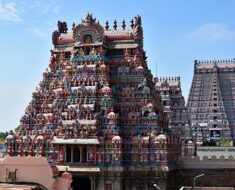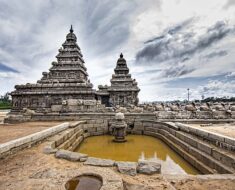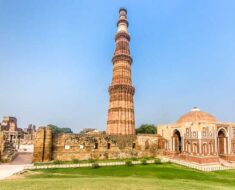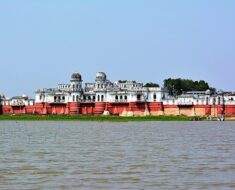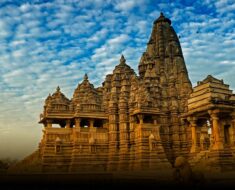Golden Temple, Amritsar – Four Doors To Heaven
And no, I’m not talking about the supposed heaven said to be present above the skies in a different realm.
This post is about heaven present on our very own earth. Yes, you read it right, heaven on earth.
There are indeed some places present on our own planet whose divinity and grandeur are in every way comparable to the supposed heaven that has been mentioned in almost all religious philosophies.
One such place is present in the northern plains of India, in the magnificent state of Punjab in a city named Amritsar.

The place is known as the Harmandir Sahib literally meaning Abode of the lord.
Harmandir Saheb is the holiest of all Sikh shrines in India.
It is also called Darbar Sahib but is more popular all around the world by the name of Golden Temple due to its distinctive gold embellished walls which give it the famous extravagant looks.
Anyone who has had the privilege of visiting this place would understand why it is being compared to heaven itself.
One step inside this shrine and you would be transported to another world, a world of spirituality and inner peace.
The serenity and calmness of Golden Temple lets you dwell deep into your inner self and discover yourself all over again. The feeling is literally surreal.

The sublime peacefulness of the shrine leaves one spellbound. The recitation of hymns from the Holy Guru Granth Sahib Ji carries on nonstop inside the Gurudwara premises.
People from all walks of faith visit the shrine on a daily basis and feel blessed by immersing themselves in the holy nectar of the Lord’s name and praise.
The shrine is unique in the sense that it has four doors to enter which were made as a symbol to the world that this shrine is open to people of all the four major religions of the world.
It’s a place that serves as a spiritual guiding light, not only for the Sikhs but the entire human race.
Read More: 22 Incredible Ancient Temples In India
History of Golden Temple
Going back in history, the holy city of Amritsar was founded by the fourth Sikh Guru Shri Guru Ramdas Ji in the early 15th century.
It was at that time called Ramdaspur or Chak Ramdas. He also excavated a pool of water said to contain miraculous healing properties.

It was after this mystical pool or Sarovar as it is called in the native tongue, that the city was rechristened as Amritsar meaning the land of holy nectar.
The work started by the 4th Guru Sahib was carried on by his successor Shri Guru Arjun Dev Ji.
He was the one who envisaged the creation of a holy place of worship in the newly founded city right in the middle of the Amrit Sarovar.
The foundation stone of the shrine was laid somewhere around December 1588 and its work got completed in 1601 under the direct supervision of Guru Sahib.
Thereafter, he got the newly compiled Guru Granth Sahib Ji installed in the shrine and made a devout Sikh Baba Buddha Ji the first Granthi – Main reciter.
In the year 1606, the sixth Guru Shri Guru Hargobind Sahib Ji laid the foundation stone of the Akal Takht – the seat of spiritual authority inside the complex as a symbol of defiance against the tyrannical Mughal government of that time.
Akal Takht subsequently became the political headquarter of the Sikh community and all important decisions regarding the affairs of the community were taken there.
So the shrine of Harmandir Sahib became the highest seat of the spiritual and temporal power of the Sikhs.
It was attacked and vandalized many times by the enemies of the community but each time it was rebuilt with even more magnificence
Golden Temple – Foundation Stone

Although the entire construction of the Harmandir Sahib was done under the direct patronage and supervision of Shri Guru Arjun Dev Ji, he did not lay the foundation stone himself.
He chose a Muslim saint Sain Miyan Meer to lay the foundation of what was to become the greatest Sikh shrines of all time.
This is another testament to the fact that the great Guru believed deeply in secular ethos and wanted the shrine to be welcoming to all.
No such example is found in the history of any other religion
Architecture of the Golden Temple

Another interesting fact to note is that contrary to the normal practice of making religious shrines on a higher level compared to the ground, Guru Sahib got it built on a lower level.
So, one has to come down the stairs to enter the shrine.
This was a metaphorical sign to leave one’s ego behind and introspect deeply with profound humility towards the almighty lord.
The Layout of the Golden Temple

The Sanctum Sanctorum is built on a 67 square feet platform in the center of the holy Sarovar.
The structure itself is around 40.5 square feet.
As mentioned before it has four doors on all four sides to convey its openness to people from all religions.
The darshani Deori is present at the shore end of the causeway.
The door frame of the Deorhi is about 10 feet in height. It opens to the causeway about 202 feet long and 21 feet wide leading to the main building of the Darbar Sahib.
The bridge is connected with the 13 feet wide Pardakshna (circumambulatory path). The whole layout presents a grand and mystical look to the shrine.
Gold Embellishment – Harmandir Saheb

It is also very interesting to note that the Golden Temple was not always golden.
In fact, the gold embellishment work was done much later in the 18th century by the donations and patronage of Maharaja Ranjeet Singh who was the then ruler of the undivided Punjab.
The marble and gold work was initiated by him as a token of respect and gratitude towards the holy shrine.
An estimated 100 kg of gold was used to embellish the top half of the shrine with gold sheets thus giving it the unique extravagant look by which it is known today.
Devotees at Golden Temple

It is estimated that on average 100000 people visit the shrine on a daily basis.
This number doubles on important functions such as Gurpurab or Baisakhi.
This makes Harmandir Sahib among the top-visited shrines in the world which are thronged by pilgrims belonging to different religions, castes, and creeds.
Langar Service of Golden Temple
It is estimated that on average 100,000 people visit the shrine on a daily basis. This number doubles on important functions such as Gurpurab or Baisakhi.
This makes Harmandir Sahib among the top-visited shrines in the world which are thronged by pilgrims belonging to different religions, castes, and creeds.

The community kitchen or Langar as it is popularly called is an age-old practice started by the founder of Sikhism Shri Guru Nanak Dev Ji wherein he welcomed people from all castes, creeds, religions, and social statuses to come and partake in simple meals sitting together on the ground.
It was aimed at renouncing distinctions between people of different religious and social statuses.
The Langar service at Golden Temple serves around 50000 people on weekdays and close to 100000 people on weekends.
This is no small feat in itself. In fact, it is a herculean task but the devotion and selfless service of sewadars make it possible.
About 60 quintals of wheat, 18 quintals of daal, and 14 quintals of rice are daily processed and consumed in the Langar. It is thus the biggest kitchen in the world.
Every day over 100 gas cylinders are needed to fuel the kitchen. At one time close to 5000 people are served in the two langar halls.
The whole system right from arranging the raw materials to cooking and then serving is highly organized and efficient.
It is astonishing to note that around 90% of the staff is made up of volunteers who can help out for as long as they want and then leave.
Read More: 10 Famous Ancient Temples in Tamil Nadu – Religious Places
Daily Practice at Darbar Saheb

Every morning the holy Shri Guru Granth Sahib Ji is brought from the Akal Takht Sahib in a gold palanquin along with a shower of flowers and is taken to the sanctum sanctorum by means of hundreds of devotees giving a shoulder to the palanquin for a few seconds on either side of the connecting bridge.
After the evening prayers, it is again returned to the Akal Takht Sahib in a similar manner and the Sanctum hall is washed with milk.
Read More: Oldest Hindu Temple in India – Mundeshwari Devi Temple
Attacks and Fate of Attackers
The Harmandir Sahib has been the target of various attacks from time to time causing it to be repaired and rebuilt a number of times.
The majority of these attacks were perpetrated in the 18th century by Afghan invaders who believed that the shrine was the source of the power of Sikhs and that by destroying it they could destroy the Sikhs.
Needless to say, they were themselves destroyed whereas the Sikh community endured every hardship with their never-say-die attitude and emerged victorious eventually.
The major invaders were Massa Rangarh, Yahia Khan, Zakria Khan, Jahan Khan, and Ahmed Shah Abdali.

The latest assault on the shrine happened in 1984 when the Indian Army was ordered by the then Prime Minister of India, Mrs. Indira Gandhi to attack the shrine with tanks and helicopter gunships in order to flush out pro-Khalistan activists.
A large number of innocent devotees were killed in the attack and severe damage was caused to the entire complex thereby spreading outrage in the entire community.
However, an interesting fact to note is that none of the persons responsible for perpetrating the attacks on Shri Harmandir Sahib could live on for more than 5 months.
In fact, everyone died within 153 days of the attack. This strengthens the belief that anybody who dares to target the abode of the lord shall not be spared by the lord.
Here is a brief chronology of the above-mentioned events
- ATTACK 1
- Date of attack: 7th Aug 1740
- Name of the attacker: Massa Ramgar
- Date of death: 2nd January 1741
- Days lived after 153
- ATTACK 2
- Date of attack: 13th November 1746
- Name of the attacker: Yahia Khan
- Date of death: 13th April 1747
- Days lived after 153
- ATTACK 3
- Date of attack: 18th Jan. 1757
- Name of the attacker: Jahan Khan
- Date of death: 9th June 1757
- Days lived after 153
- ATTACK 4
- Date of attack: 5th Feb 1762
- Name of the attacker: Ahmed Shah Abdali
- Date of death: 8th July 1762
- Days lived after 153
- ATTACK 5
- Date of attack: 1st June 1984
- Name of the attacker: Indira Gandhi
- Date of death: 31st Oct 1984
- Days lived after 153
Some More Amazing and Interesting Facts about the Golden Temple
- Before the Golden Temple was built, the first Guru of the Sikhs, Guru Nanak Dev Ji, used to meditate at the site.
- 35% of the pilgrims that visit the Golden Temple are from faiths other than Sikh.
- The name of Maharaja Ranjit Singh has been inscribed on the entrance, who donated gold to the Golden Temple

- Golden Temple, Langar Sewa served 1 Lakh J&K flood victims in Sept 2014 by providing food.
- Golden Temple was ranked 6th when BBC’s popular holiday program asked its viewers to rank the place to see before dying. Taj Mahal was ranked 10th.
- Taj Mahal attracted 3 million visitors in the year 2013. Golden Temple is visited by 3 million pilgrims in a month.
- With hand-painted mosaics and patterns, the Golden Temple is one of the most significant symbols of Mughal and Indian architectural genius.
- The Central Sikh Museum is located inside the Golden Temple and was opened in 1958. The Museum houses a rich and varied collection of old arms, coins, and ancient manuscripts

